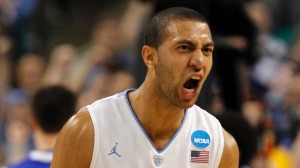Kendall Marshall breaks wrist
The news doesn’t seem to get better concerning the broken wrist of North Carolina point guard Kendall Marshall.
Jeff Goodman of CBS Sports just tweeted this:
“Just spoke with Dennis Marshall – Kendall’s father. Confirmed surgery scheduled for tomorrow morning to insert screw in non-shooting wrist.”
It is unclear whether he would be ruled out of the tournament if he has surgery.
Marshall was injured when he was fouled by Ethan Wragge of Creighton on a drive to the basket in the second half. Marshall played for another nine minutes.
With injuries earlier this season, the Tar Heels are down to 6-foot freshman Stilman White.
North Carolina point guard Kendall Marshall broke a bone in his right wrist during the second half of Sunday’s win against Creighton in the NCAA tournament.
Marshall was hurt when he drove to the paint and was knocked to the floor by Ethan Wragge with 10:56 left. The left-handed point guard hit one of two free throws, then left the game briefly before returning and playing about 7 more minutes before leaving for good with 1:54 left.
Coach Roy Williams later cleared reporters out of the locker room to inform the team of Marshall’s injury. His status for North Carolina’s game against Ohio on Friday in the round of 16 in St. Louis is unclear. Team spokesman Steve Kirschner said medical staff planned to put Marshall in a cast Sunday night for his comfort.
“All we know right now is it’s a fracture” – Marshall said. “Luckily it’s my right hand. If it was my left hand, then we’d probably have some problems. But we’ll take it day by day and figure it out.”
Dennis Marshall (Kendall’s father) told CBS.com on Sunday night that his son would have surgery Monday morning to insert a screw in the injured wrist.
Marshall has been the team’s most irreplaceable player while driving Williams’ fast-paced attack with unparalleled court vision and perfect pitch-aheads in transition. He’s averaging about 10 assists per game and set the Atlantic Coast Conference’s single-season assist record during last week’s league tournament.
The pass-first point guard scored 18 against Creighton, his sixth straight game in double figures after doing so just four times in the first 30 games. He also had 11 assists.
http://www.youtube.com/watch?v=nD0i5FQMzF8
Kendall Marshall suffered a fracture of his scaphoid bone against Creighton on Sunday night during the NCAA’s Round of 32 in Greensboro, overshadowing most of the good feelings North Carolina had about their victory.
And as I noted earlier, UNC isn’t providing any update. But I spoke to Dr. Mark Warburton, a renowned orthopedic surgeon at High Point Orthopedic and Sports Medicine in High Point, North Carolina about what the fracture means.
Dr. Warburton explained that the scaphoid bone is the “most commonly fractured” wristbone because it spans the two rows of bones (eight total) in the wrist.
There are two types of fractures to the scaphoid bone: either the fracture is “in place” or “displaced” and that will decide whether or not Marshall needs surgery.
If the fracture is in place, Dr. Warburton said, surgery isn’t necessarily a requirement. But if Marshall’s injury is a “displaced fracture” (read – the bone isn’t lined up), there’s no realistic way for him to avoid surgery.
“If it’s out of place, there is no way to set the bone like you would set and arm or a leg” – Dr. Warburton explained. “So the only thing you can do is do surgery and today what is done is you basically through small incisions you can set the bone and put a pin in it.”
While Marshall and North Carolina would clearly like to avoid surgery, a displaced fracture will eliminate that choice, provided that Marshall’s long-term health is the No. 1 priority.
“If the bone is out of position at the time of injury then you have to operate on it” – Dr. Warburton explained. “Otherwise it will heal in the wrong position.”
Should the x-rays reveal that Marshall’s fracture is “in place,” he could simply have a cast put on and let it heal naturally.
“If the bone is not out of position, that gets to be a little bit more of a grey area” – Dr. Warburton said. “If it’s not out of position you can put it in a cast and keep it in a cast for six or eight weeks until it does heal.
“The problem there is, sometimes it doesn’t heal and you have to end up operating on it.”
